What's in bloom in October 'til frost Wildflowers in our region in bloom into late fall. Weeds! Click here
This is a quick guide to some of wildflowers you might see in bloom in our region in September. Do a web search on each plant for larger photos and detailed information. Fall blooming happens first in the north and at higher altitude, than later in the south.
If you know of a flowering wild plant that is missing, contact webkeeper@amcdv.org. All photos are in the commons for non-commercial use, as is the information on this page.
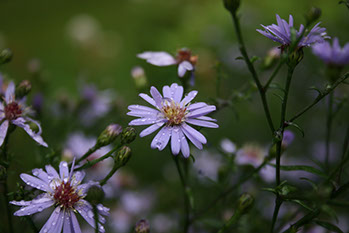

Blue Wood Aster, Symphyotrichum cordifolium, syn. Aster cordifolius, is a perennial native to eastern North America, found along woodland verges and in open areas. The pale blue to purple flowers bloom from mid-August through fall in our area. Flowers have 10 to 15 rays with a yellow to red center and can grow to four foot tall.
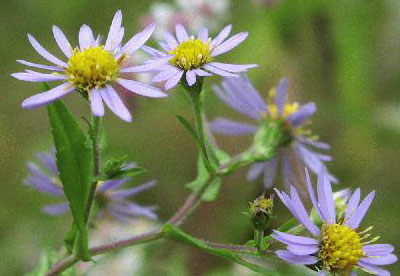
Crooked-Stemmed Aster, Symphyotrichum prenanthoides, a perennial native from southern Ontario to Tennessee, Minnesota to the Atlantic Coast and southern New England. The stem of crooked-stemmed aster is smooth and zig-zags between leaves that are large and toothed and clasp the stem. Flowers are an inch or more across. Blooms in fall.
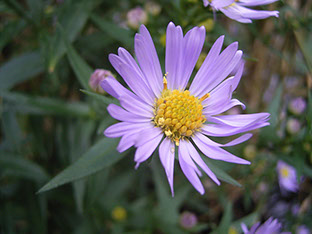

New York Aster, Symphyotrichum novi-belgii, (left) New England Aster, Symphyotrichum novae-angliae, (right) are perennials native to northeastern North America. They are the source of more than a thousand cultivated varities. Bloom August into fall.

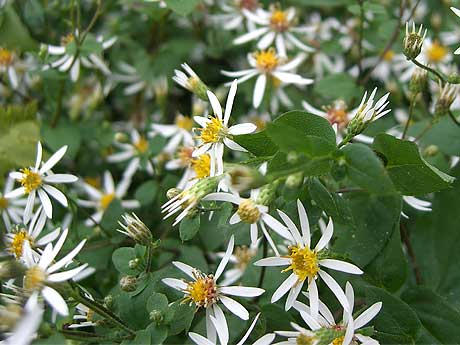
White Aster, Eurybia divaricata, formerly Aster divaricatus, is a perennial native to eastern North America, especially the Appalachians, found in the woods, along woodland verges and in open areas. The white flowers bloom from mid-August through fall in our area. Flowers have 10 to 15 rays with a yellow center and and rarely grows more than two foot high.

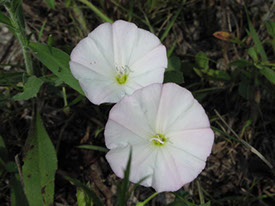
Field Bindweed (above), Convolvulus arvensis. Introduced in the mid 1700s as a crop seed contaminant. Blooms June through fall. This is wild morning glory, so the flowers will close and wither as the day progresses. Flowers that range from pure white to heavily colored or streaked with pink and lavender.
Field Bindweed is distinguished from Hedge Bindweed, Convolvulus sepium, (below) not only by where it choosed to grow, but by the leaves. The plants have three lobed leaves. The base lobes, those closest to the stem, are pointy on the Field Bindweed while those on the Hedge Bindweed are blunt. Will survive until frost

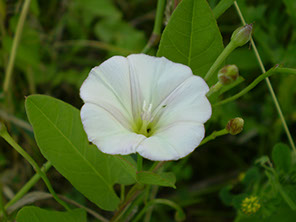
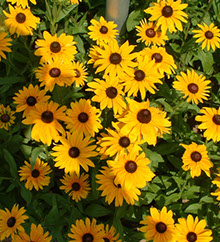

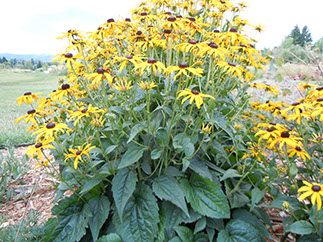
Blackeyed Susan, Rudbeckia hirta, North American native that blooms July into fall. It is an annual that likes moist meadows and woodland verges. Flowers are up to four inches across. The state flower of Maryland. Bloom summer into fall.
Below are photos of Rudbeckia triloba, the Brown Eyed Susan. A much-branched, hairy-stemmed, short-lived perennial, two to five feet tall, with more numerous flowers than R. hirta, with shorter and fewer petals. A biennial or short-lived perennial native to the eastern US.


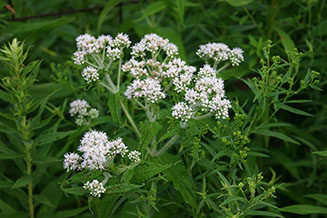
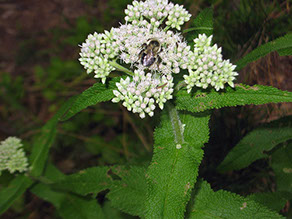
Boneset, Eupatorium perfoliatum, is a perennial native to North America east of the Rockies. It prefers damp soil, and blooms well into the fall. Grows up to three feet tall.
Other members of the large family of Boneset and Throughwort plants include Eupatorium sessilifolium , Upland Boneset (below, left) and Eupatorium resinosum, Pine Barrens Boneset (below right). There are more than 20 species known, and to make matters even more complicated, their native ranges overlap and they easily hybridize.

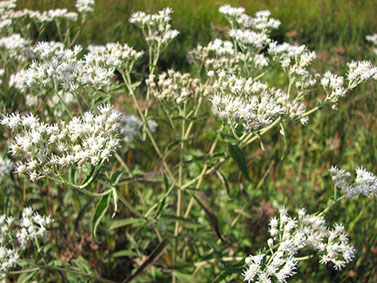
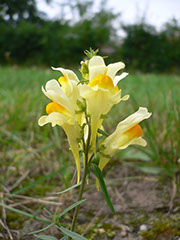

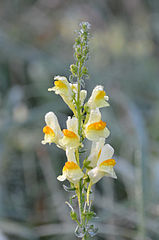
Butter and Eggs, Yellow Toadflax, Linaria vulgars, a Eurasian native and relative of the snapdragon, brought to this country as a garden plant, it has escaped and grows wild across all of North America. This perennial favors well-drained disturbed soils and sunny locations, and produces long-lasting cut flowers. Blooms late July through frost in our area.
Lots of Goldenrod on its own page.
Many asters are now in flower. So is the ragweed. Most of these flowers will continue to bloom until frost. Some will survive up to a heavy freeze.
These wildflower pages are a multi-year project. If you wish to be a flower spotter, or otherwise help, contact webkeeper@amcdv.org.
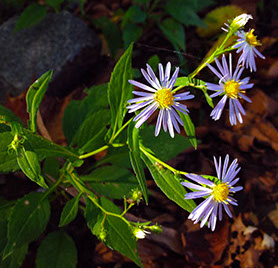
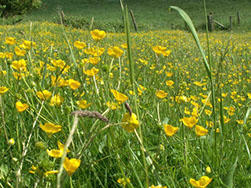

Buttercups, Ranunculus species. Many species of buttercups may be found in our area, some native some not. Most bloom spring through fall.
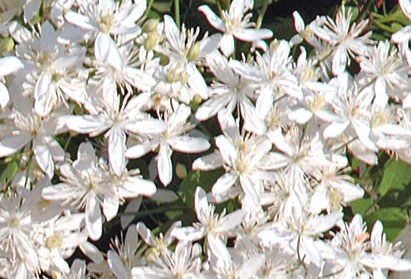
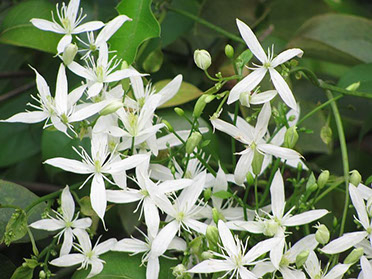
Clematis, Virginia Bower Vine, Clematis virginiana, a perennial climbing vine with fragrent flowers hative to eastern North America. Blooms mid-summer through fall.
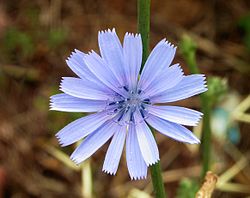
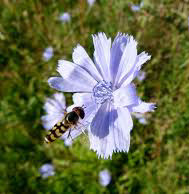

Chicory or Cornflower, Cichorium intybus, a European native naturalized across all of North America. Blooms July through fall. The wild version of the plant cultivated for salad greens, Belgian endive and whose roots are used as a coffee additive or substitute.
1.jpg?crc=240919899)
3-crop-u19252.jpg?crc=4284324365)
2.jpg?crc=330717236)
Daisy Fleabane, Erigeron annuus. Also Philadelphia Fleabane, Erigeron philadelphicus, Both look nearly the same, but the latter plant has leaves that closly clasp the stem. Both bloom May well into fall.
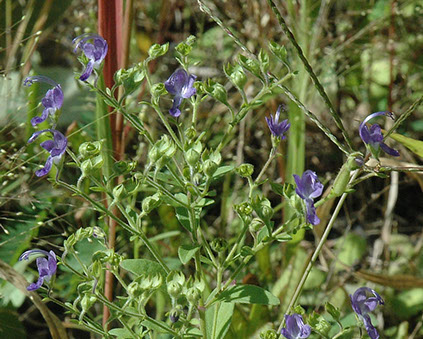

Forked Bluecurls, Trichostema dichotomum, an annual of the mint family native to North America from Ontario to Georgia to Texas to Minnesota. Blooms August into fall.

Goldenrod is the name given to 125 species of beautiful flowering plants, most of which are native to North America.


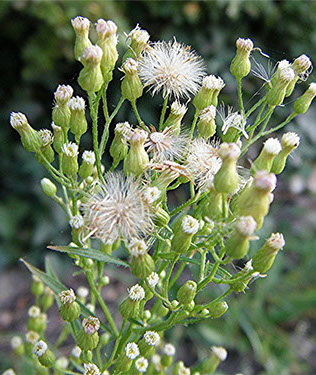
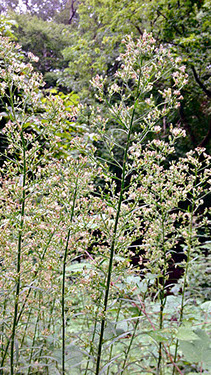
Horseweed or Canadian Horseweed, Conyza canadensis, is an annual native to most of North America except Alaska, Yukon and the the other far norther regions. It is now spread across most of the northern hemisphere. It does well in poor soils and is often found along the sides of roads. Usually it is eventually displaced by perennials, if they are allowed to grow. Flowers are less than dime sized, and the plant rarely more than three feet high.Blooms untill frost.


Ironweed: Vernonia altissima (tall Ironweed, left) , Vernonia noveboracensis, (New York Ironweed) and several other similar and related species are native to eastern North America and prefer moist to damp meadows. Altissima can reach 10 foot tall!
,

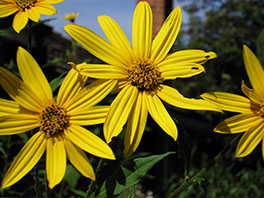
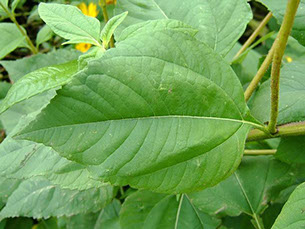
Jerusalem artichoke, Helianthus tuberosus, a perennial native to eastern and central North America. Long cultivated by American Indians before the arrival of Europeans, this plant is still raised commercially and the edible and tasty tubers sold as sunchokes or as Jerusalem artichokes, which are delicious raw or cooked. Grows up to 10 foot high. The flowers are similar to Tickseed Sunflower, Bidens aristosa, (see September) but the leaves are broad and the stems are branched and hairy.
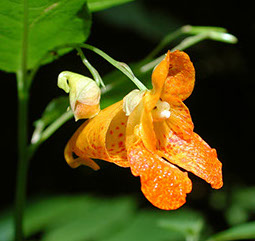
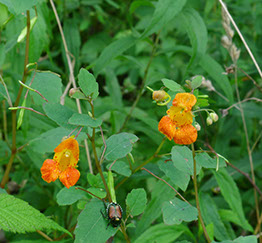
Jewelweed, Spotted Jewelweed, Orange Jewelweed and Touch-me-not are all names for Impatiens capensis, a native North American annual plant with juicy, glassy stems. Dermatological studies have confirmed that crushed jewelweed stems are effective in mitigating contact with poison ivy if applied after contact, followed by rinsing with water. Soap works better, but then few of us carry soap on day trips. Blooms late July into October in our region. May be almost all orange or almost all yellow. The similar Pale Jewelweed, Impatiens pallida, shown below, often grows side by side.

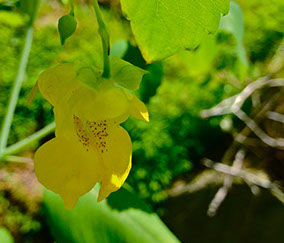
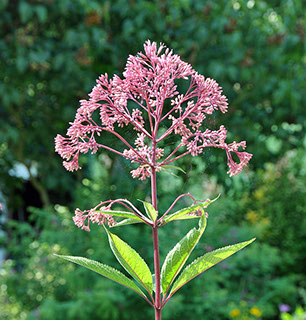
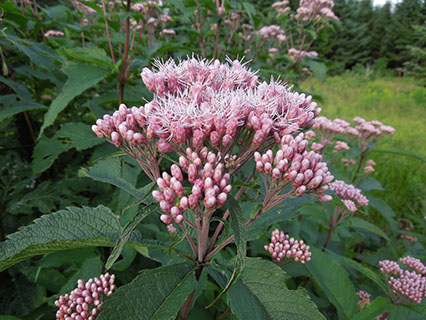
Joe Pye Weed, Eutrochium maculatum, is native to northeastern and north central North America as far south as Kentucky. This perennial grows as tall as five or six feet, and favors moist to wet soil and full sun. Its native habitat is marshes, but it does well in roadside drainage ditches. In our area, blooms late July into fall.

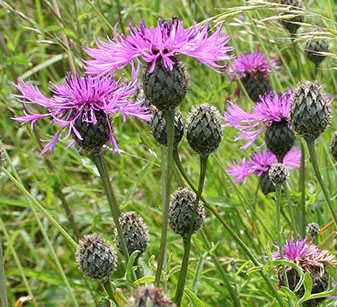
Black Knapweed, Centaurea nigra, a perennial of Eurasian origin that blooms in late summer and fall. The base of the flower is dark. There is also a Brown Knapweed, with a lighter brown flower base.

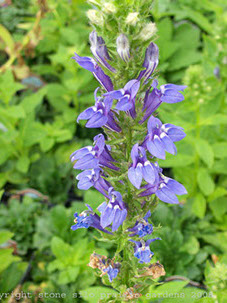
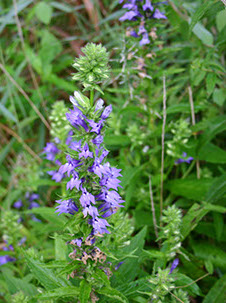
Great Blue Lobelia, Lobelia siphilitica, native to eastern and central North America, is a short-life perennial (lives just a few years) that blooms August well into fall in our area. Grows up to three feet tall and prefers wet to very moist soil.
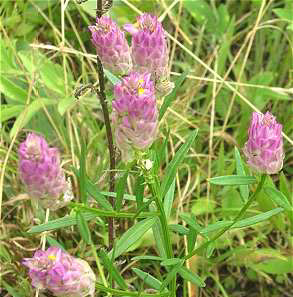
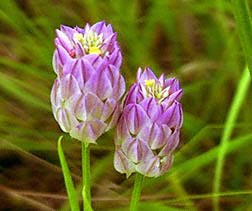
Milkwort, Field Milkwort or Purple Milkwort, Polygala sanguinea, an annual native to most of eastern North America, except for the coastal plain. Likes damp open fields and blooms August through fall.
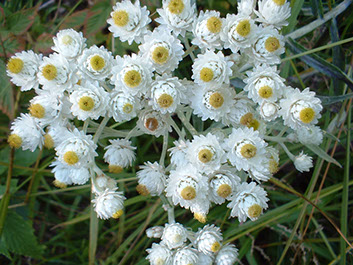
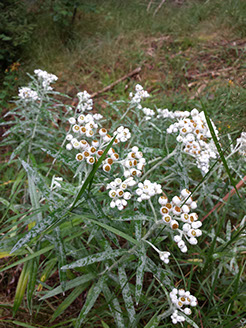
Pearly Everlasting, Anaphalis margaritacea, is native to most of North America, except for the region along the Gulf of Mexico. This perennial favors sunny, well drained locations, and its tiny white blossoms are beloved by butterflies and flower arrangers, who use it as a dried flower. Blooms August into fall.
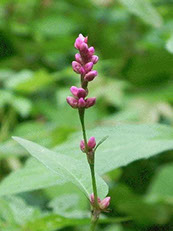
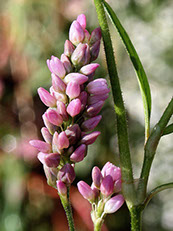
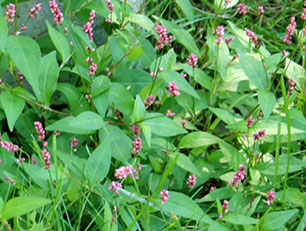
Pennsylvania Smartweed or Knotweed, Polygonum pensylvanicum, an eastern North American native, member of the buckwheat family. Smooth edged eaves about an inch long, pinhead sized buds in elongated clusters, tiny flowers. Major food source for birds. Blooms throughout summer into fall. Also see Virginia Smartweed.
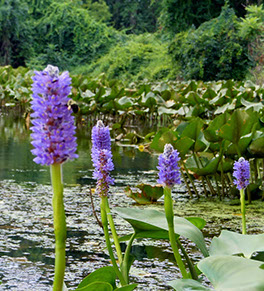
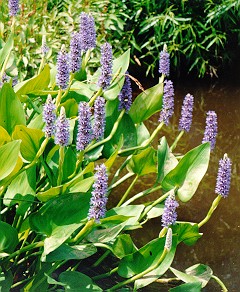
Pickerel Weed, Pontederia cordata, is a perennial emergent aquatic native to the eastern Americas from Canada to Argentina. It likes full sun and quiet water, and so grows along lake, pond and marsh edges. It grows about four feet high, with the bottom rwo feet underwater. Blooms June through fall in our area.
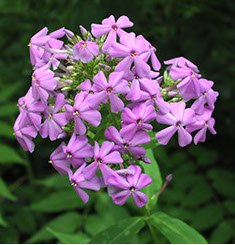
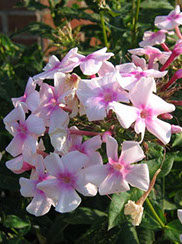
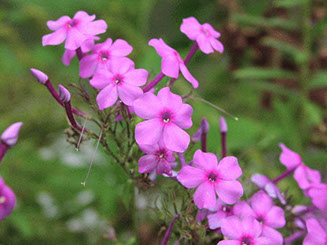
Phlox: Fall Phlox or Garden Phlox, Phlox paniculata, an Appalachian Mountain native perennial now widely cultivated as a garden plant. Blooms August into fall with five-petal flowers ranging from deep pink to nearly white.


Evening Primrose, Oenothera biennis, native to eastern and central North America, a biennial with one to two-inch wide flowers that bloom in the evening and close by noon. Fragrance is somewhat like lemon. Keeps blooming through fall. Grows two to six feet high.
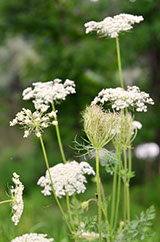

Queen Anne's Lace, Daucus carota, native of Europe, now found worldwide. May or may not have a tiny red flower in the center. The wild ancestor of the carrot. Pull one and look at and smell the root. Blooms untill heavy frost.

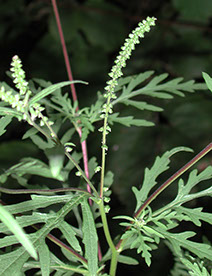
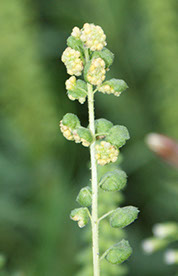
Ragweed, Ambrosia psilostachya, the notorious plant who's pollen is the cause of allergy misery for millions, is a perennial that is native to North America from the southerm provinces of Canada to northern Mexico. Very tiny flowers grow in clusters at the tips of the stems. Blooms untill frost.

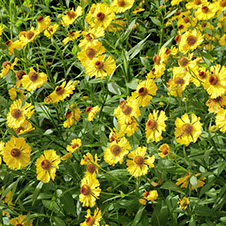
Common Sneezeweed, Helenium autumnale, is not an allergy-inducing plant. The name come from its former use: it was dried, powdered and used as snuff. It is a perennial native to eastern North America that can grow up to five foot tall, and blooms from August well into fall.
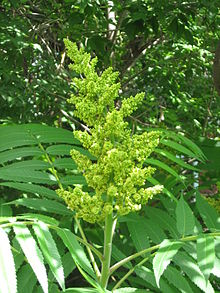

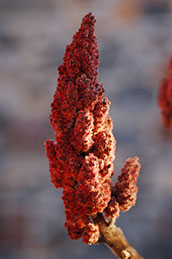
Staghorn Sumac, Rhus typhina, is a flowering and fruiting perennial deciduous shrub that grows as high as 15 foot tall, It is native to northeastern United States, adjoining parts of Canada, and south along the Appalachian spine. It flowers largely unoticed in May and June, but by late July and through fall bears conical clusters of deep red fruit that have the appearence of flowers. This fruit can be mashed and soaked in cold (not hot) water for four to eight hours, strained or filtered, and sweetened to make a delicious beverage. Staghorn sumac is not at all related to poison sumac. In the fall the leaves of this plant turn brilliant red, yellow and orange before dropping. Photos show flower, ripe and dried fruit.
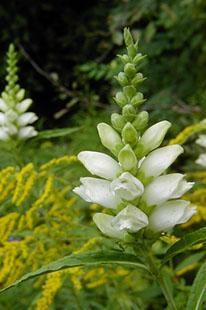


Turtlehead, Chelone glabra, is a perennial native to eastern North America from Canada almost to the Gulf Coast. Grows along river banks and in wetlands, and grows from one to four foot tall before blooming. Flowers from late July into September. A favorite food of deer.

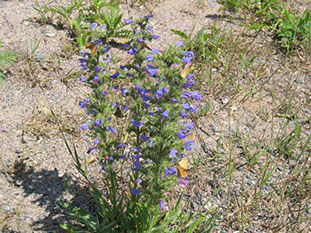
Viper's Bugloss or Blueweed, Echium vulgare, a biannual European native naturalized throughout most of North America. Sometimes grown as an oilseed plant. Grows in open areas and thrives in poor soil.


Virginia Dayflower, Commelina communis, a perennial native to mid-Atlantic and southeastern US, Flowers last one day, and bloom from July into fall.
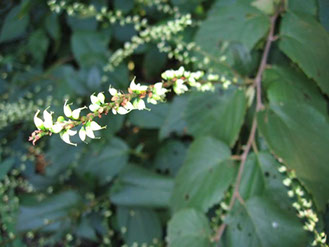
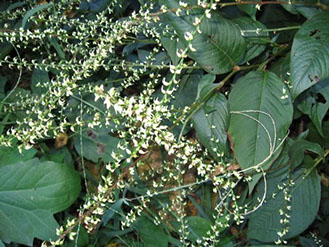
Virginia Smartweed or Virginia Knotweed or Jumpseed, Polygonum virginianum, like Pennsylvania Smartweed, is a member of the buckwheat family. It is a perennial native to the eastern half of North America from Canada to the Gulf Coast. Blooms August into the fall. Does well in full shade.


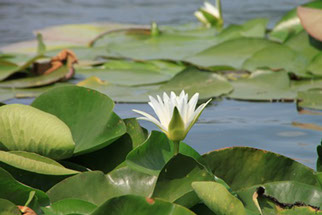
Water Lily, Nymphaea odorata, a native plant found in the shallow parts of lakes and ponds from central America to northern Canada. Blooms July through fall.
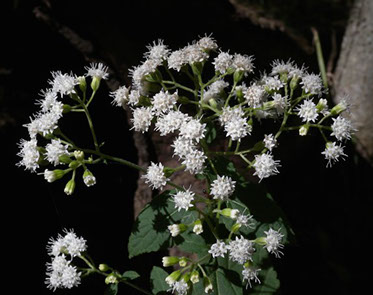
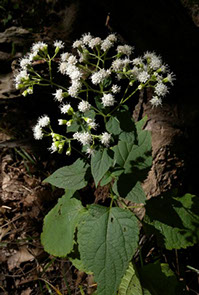
White Snakeroot, Ageratina altissima, syn. Eupatorium rugosum, a shade and moisture loving perennial native of eastern and central North America. Grows 1.5 to 3 foot high. It is toxic to humans and animals, and dairy animals that graze on it can concentrate it and produce milk harmful or even lethal to humans. Blooms through fall. Also see Boneset.
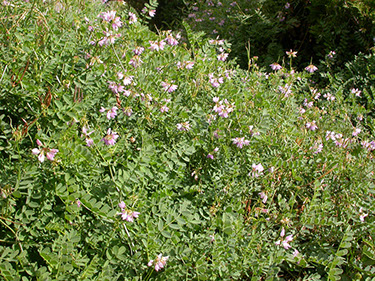
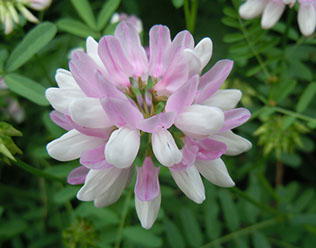
Problem invasive? Crown Vetch, Coronilla varia, is a nitrogen-fixing Eurasian native of the pea family widely used for erosion control since the 1950s. It was once extensively planted along highway cuts and embankments, but it's use has declined since it attracts deer, who like to eat it, and it is sensitive to the herbicides overused by some agencies (e.g., PA Turnpike Commission). Also planted as green manure crop to improve soil. Crowds out native vegetation. Blooms from June throughout summer.
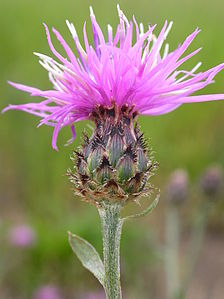
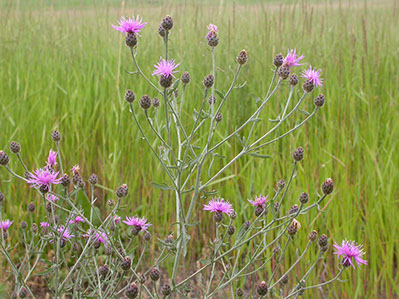
Problem invasive species: Spotted Knappweed, Centaurea maculosa, is a biennial eastern European native that first reached North America the 1800s as a seed contaminant. It out-competes native species by prolific seed production, a deep, water-sucking tap root, and by being inedible to grazing animals. Blooms August through fall in our area.
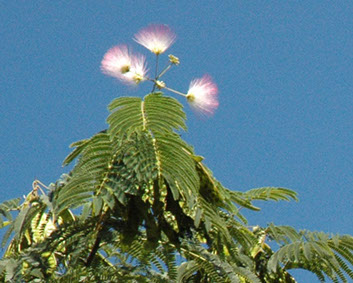
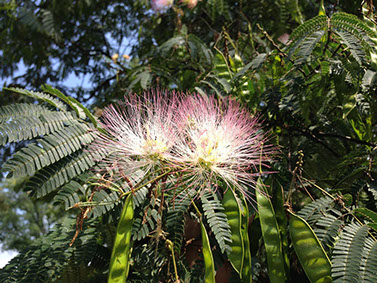
Problem invasive: Mimosa Tree, Albizia julibrissin, Is an Asian import, often planted for its beautiful flowers and foliage. It now grows wild in the US south of Massachusetts. It often bears seeds and flowers at the same time. Breeders are attempting to produce a seedless tree to make it more suitable for ornamental planting. It is fast growing small tree that is often a pioneer species in vacant lots and disturbed soils. Its main problem is that it displaces native species. Fortunately, it is plagued by fungal diseases in the eastern US, which keep it somewhat under control. Blooms summer through fall.
